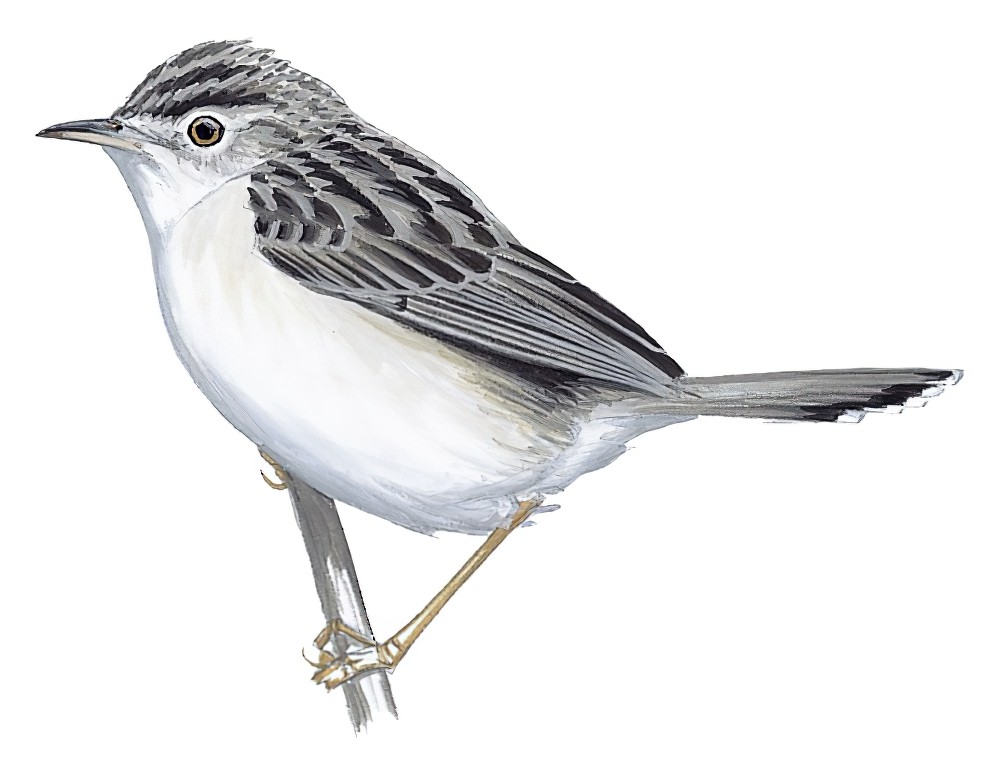Socotra Cisticola / Cisticola haesitatus

Socotra Cisticola
SCI Name:
Protonym: Drymoeca haesitata Proc.Zool.Soc.London Pt1 p.166
Taxonomy: Passeriformes / Cisticolidae / Cisticola
Taxonomy Code: soccis1
Type Locality: Socotra.
Author: Sclater & Hartlaub
Publish Year: 1881
IUCN Status: Near Threatened
DEFINITIONS
CISTICOLA
(Cisticolidae; † Zitting Cisticola C. juncidis cisticola) Gr. κιστις kistis little basket < dim. κιστη kistē basket; L. -cola dweller < colere to dwell (cf. specific name Sylvia cisticola Temminck, 1820 (= subsp. Cisticola juncidis)); the Zitting Cisticola, formerly known as Fan-tailed Warbler, is the only European member of this wide-ranging Old World, predominantly Afrotropical, genus of small monomorphic warblers; “2. Sylvia cisticola. ... 2. Zistensänger. Cisticola. E[ntwickelung]. Wie gewöhnlich. Ch[arakter]. Kleine Oleandersänger mit hellrostfarbigem, schwarz geflecktem Rücken. L[ebensart]. Sie leben wie die übrigen Rohrsänger, bauen aber ein trichterförmiges Nest ins hohe Gras.” (Kaup 1829); "Cisticola Kaup, 1829, Skizzirte Entwickelungs-Geschichte Europäisch. Thierwelt, p. 119. Type, by tautonymy, Sylvia cisticola Temminck." (Traylor in Peters, 1986, XI, p. 84).
Var. Cisiticola.
Synon. Calamanthella, Cistodyta, Drymodyta, Drymodytops, Dryodromas, Hemipteryx, Merion, Neocisticola, Nephelicola, Pseudhemipteryx, Rhathymodyta, Tachydyta, Threnetes, Threnodyta, Threnodytops, Threnolais.
cisticola
Gr. κιστις kistis little basket < dim. κιστη kistē basket; L. -cola dweller < colere to dwell.
haesitata / haesitatus
L. haesitatus hesitant, undecided, perplexing < haesitare to falter.
• "2. DRYMŒCA HÆSITATA, sp. nov. ... This little Drymœca (with ten rectrices), of which there is but one specimen in the collection, is so very like the well-known D. madagascariensis, that at first sight we considered it to be identical. But after a more accurate study we have changed our opinion. The Socotran species is altogether a smaller bird; and the relative dimensions are different, the tail being decidedly longer in D. hæsitata. It is also differently coloured" (P. Sclater & Hartlaub 1881) (Cisticola).
• "180. Procellaria haesitata F. (*) (Fig. pict. G.) Procellaria supra cinerea, subtus candida, rostro flavescenti et nigro, pedibus coerulescentibus, palmis flavis. Habitat in lat. 48o Oceani pacifici antarctici. Diu mecum haesitavi, an non haec Procellaria eadem esset cum Proc. Puffino, at magnitudo et varii characteres evincunt, hanc diversae esse speciei. Corpus magnitudine Proc. glacialis vel paulo maius. ... (*) Proc. hasitata Kuhl Beitr. p. 142. Temm. Pl. color. tab. 416. Proc. alba Auct. var. β et Proc. leucocephala F." (Forster 1844) (syn. Procellaria cinerea).
• "3. Z. (?) olivacea (L.) ... Mir unbekannt. Ob wirklich ein Zosterops? ... 5. Z. haesitata, nob. Supra in fundo cinerascente olivaceo-induta, sincipite subnigricante; subtus cinerea; abdomine imo conspicue rufescente; uropygio, remigum et rectricum marginibus externis laetius virentibus; annulo circa oculum niveo; subcaudalibus dilute flavis; rostro nigro, pedibus pallidis. ... Zwei Exemplare in der Pariser Sammlung. Bourbon: Leclancher." (Hartlaub 1861) (syn. Zosterops olivaceus).
UPPERCASE: current genus
Uppercase first letter: generic synonym
● and ● See: generic homonyms
lowercase: species and subspecies
●: early names, variants, mispellings
‡: extinct
†: type species
Gr.: ancient Greek
L.: Latin
<: derived from
syn: synonym of
/: separates historical and modern geographic names
ex: based on
TL: type locality
OD: original diagnosis (genus) or original description (species)












